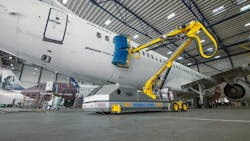Protect Aircraft Exteriors and Prevent Corrosion with Robotic Washers
Aircraft washing helps maintain the integrity of the aircraft's exterior and prevent corrosion. There has been a significant increase in demand for aircraft exterior cleaning services, and the market is projected to double in size to reach $2.06 billion by 2030. Jo Alex Tanem, CEO of Nordic Dino Robotics, a leading manufacturer of an innovative and semi-automatic family of Nordic Dino aircraft exterior cleaning robots, which is part of the Avia Solutions Group family, an ACMI (Aircraft, Crew, Maintenance, and Insurance) provider explains how protocols of robotic aircraft washers and advancement in aviation technology preserve the appearance and guarantee safe operation.
According to studies performed by Bio Water Synergistics, a company that specializes in aerospace wash equipment for the military, up to 80 percent of maintenance costs during an aircraft’s life span can be attributed to corrosion. The accumulation of grease, oil, and hydraulic fluid, as well as engine soot, smoke, and insects, is corrosive to the aircraft. Neglecting this vital maintenance can weaken the aircraft’s metal parts, including wings, panels, and landing gear, which is potentially dangerous.
“Robotic aircraft washers are designed to provide a thorough and efficient cleaning process while minimizing the risk of damage to the aircraft,” Tanem says. “These washers use a combination of mechanical and chemical cleaning methods to remove dirt, grime, and other contaminants from the aircraft's exterior. Additionally, the robotic washers are equipped with high-pressure water jets that are designed to be gentle on the aircraft's exterior while still providing a thorough cleaning.”
Aircraft cleaning is far more sophisticated than it has ever been as cleaning practices have changed significantly.
"Up until the mid-2000s aircraft exteriors were cleaned in hangars to preserve the image, but now having a quick wash of wings’ leading edges, stabilizers, and aircraft’s nose at the gate is a more preferred option by the airlines. The cleaning process therefore is tailored to prevent any inadvertent damage, and specific safety features are integrated into the robotic aircraft washers to ensure that the aircraft is always protected," explains Tanem. "One example of a safety feature is the use of sensors that detect the proximity of the aircraft and adjust the cleaning process accordingly. This ensures that the robotic washer does not come into contact with the aircraft, which could cause damage," he clarifies.
The incorporation of specialized cleaning solutions, precisely calibrated to adhere to stringent aviation regulatory standards highlights the responsibility to preserve aircraft integrity while advanced sensor technologies, adept at detecting minute surface irregularities, ensure a meticulous and gentle cleaning process that eliminates the risk of abrasions or structural compromises.
